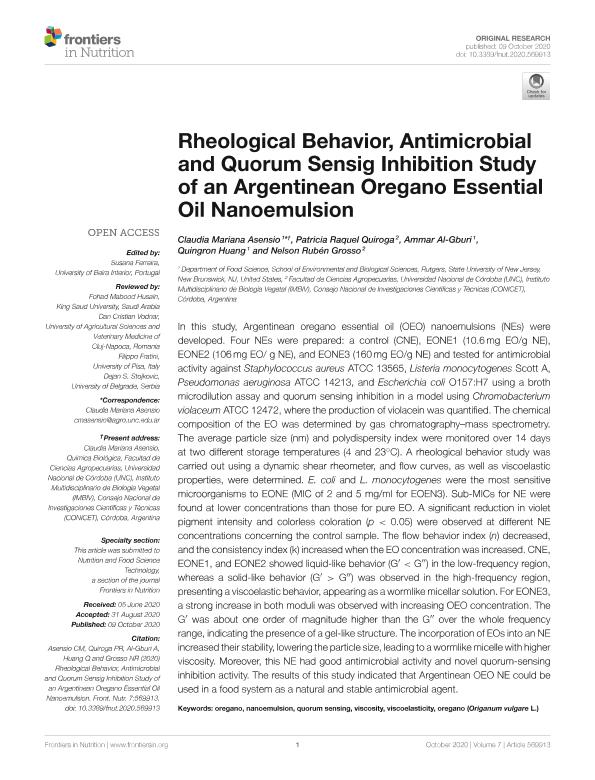Mostrar el registro sencillo del ítem
dc.contributor.author
Asensio, Claudia Mariana

dc.contributor.author
Quiroga, Patricia Raquel

dc.contributor.author
Al-Gburi, Ammar
dc.contributor.author
Huang, Quingron
dc.contributor.author
Grosso, Nelson Rubén
dc.date.available
2020-11-13T20:54:00Z
dc.date.issued
2020-10
dc.identifier.citation
Asensio, Claudia Mariana; Quiroga, Patricia Raquel; Al-Gburi, Ammar; Huang, Quingron; Grosso, Nelson Rubén; Rheological behavior, antimicrobial and quorum sensig inhibition study of an argentinean oregano essential oil nanoemulsion; Frontiers Media S.A.; Frontiers in Nutrition; 7; 10-2020
dc.identifier.uri
http://hdl.handle.net/11336/118379
dc.description.abstract
In this study, Argentinean oregano essential oil (OEO) nanoemulsions (NEs) were developed. Four NEs were prepared: a control (CNE), EONE1 (10.6 mg EO/g NE), EONE2 (106 mg EO/ g NE), and EONE3 (160 mg EO/g NE) and tested for antimicrobial activity against Staphylococcus aureus ATCC 13565, Listeria monocytogenes Scott A, Pseudomonas aeruginosa ATCC 14213, and Escherichia coli O157:H7 using a broth microdilution assay and quorum sensing inhibition in a model using Chromobacterium violaceum ATCC 12472, where the production of violacein was quantified. The chemical composition of the EO was determined by gas chromatography–mass spectrometry. The average particle size (nm) and polydispersity index were monitored over 14 days at two different storage temperatures (4 and 23°C). A rheological behavior study was carried out using a dynamic shear rheometer, and flow curves, as well as viscoelastic properties, were determined. E. coli and L. monocytogenes were the most sensitive microorganisms to EONE (MIC of 2 and 5 mg/ml for EOEN3). Sub-MICs for NE were found at lower concentrations than those for pure EO. A significant reduction in violet pigment intensity and colorless coloration (p < 0.05) were observed at different NE concentrations concerning the control sample. The flow behavior index (n) decreased, and the consistency index (k) increased when the EO concentration was increased. CNE, EONE1, and EONE2 showed liquid-like behavior (G′ < G″) in the low-frequency region, whereas a solid-like behavior (G′ > G″) was observed in the high-frequency region, presenting a viscoelastic behavior, appearing as a wormlike micellar solution. For EONE3, a strong increase in both moduli was observed with increasing OEO concentration. The G′ was about one order of magnitude higher than the G″ over the whole frequency range, indicating the presence of a gel-like structure. The incorporation of EOs into an NE increased their stability, lowering the particle size, leading to a wormlike micelle with higher viscosity. Moreover, this NE had good antimicrobial activity and novel quorum-sensing inhibition activity. The results of this study indicated that Argentinean OEO NE could be used in a food system as a natural and stable antimicrobial agent.
dc.format
application/pdf
dc.language.iso
eng
dc.publisher
Frontiers Media S.A.
dc.rights
info:eu-repo/semantics/openAccess
dc.rights.uri
https://creativecommons.org/licenses/by-nc-sa/2.5/ar/
dc.subject
NANOEMULSION
dc.subject
OREGANO
dc.subject
OREGANO (ORIGANUM VULGARE L.)
dc.subject
QUORUM SENSING
dc.subject
VISCOELASTICITY
dc.subject
VISCOSITY
dc.subject.classification
Otras Nanotecnología

dc.subject.classification
Nanotecnología

dc.subject.classification
INGENIERÍAS Y TECNOLOGÍAS

dc.title
Rheological behavior, antimicrobial and quorum sensig inhibition study of an argentinean oregano essential oil nanoemulsion
dc.type
info:eu-repo/semantics/article
dc.type
info:ar-repo/semantics/artículo
dc.type
info:eu-repo/semantics/publishedVersion
dc.date.updated
2020-11-13T17:04:45Z
dc.identifier.eissn
2296-861X
dc.journal.volume
7
dc.journal.pais
Suiza

dc.description.fil
Fil: Asensio, Claudia Mariana. Consejo Nacional de Investigaciones Científicas y Técnicas. Centro Científico Tecnológico Conicet - Córdoba. Instituto Multidisciplinario de Biología Vegetal. Universidad Nacional de Córdoba. Facultad de Ciencias Exactas Físicas y Naturales. Instituto Multidisciplinario de Biología Vegetal; Argentina. Universidad Nacional de Córdoba. Facultad de Ciencias Agropecuarias; Argentina
dc.description.fil
Fil: Quiroga, Patricia Raquel. Consejo Nacional de Investigaciones Científicas y Técnicas. Centro Científico Tecnológico Conicet - Córdoba. Instituto Multidisciplinario de Biología Vegetal. Universidad Nacional de Córdoba. Facultad de Ciencias Exactas Físicas y Naturales. Instituto Multidisciplinario de Biología Vegetal; Argentina. Universidad Nacional de Córdoba. Facultad de Ciencias Agropecuarias; Argentina
dc.description.fil
Fil: Al-Gburi, Ammar. School Of Environmental And Biological Sciences; Estados Unidos
dc.description.fil
Fil: Huang, Quingron. School Of Environmental And Biological Sciences; Estados Unidos
dc.description.fil
Fil: Grosso, Nelson Rubén. Universidad Nacional de Córdoba. Facultad de Ciencias Agropecuarias; Argentina. Consejo Nacional de Investigaciones Científicas y Técnicas. Centro Científico Tecnológico Conicet - Córdoba. Instituto Multidisciplinario de Biología Vegetal. Universidad Nacional de Córdoba. Facultad de Ciencias Exactas Físicas y Naturales. Instituto Multidisciplinario de Biología Vegetal; Argentina
dc.journal.title
Frontiers in Nutrition
dc.relation.alternativeid
info:eu-repo/semantics/altIdentifier/url/https://www.frontiersin.org/article/10.3389/fnut.2020.569913/full
dc.relation.alternativeid
info:eu-repo/semantics/altIdentifier/doi/http://dx.doi.org/10.3389/fnut.2020.569913
Archivos asociados
